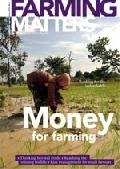The International Year of Biodiversity gives us a good opportunity look at agriculture’s relation with biodiversity.
One proposed mechanism to stimulate environmentally friendly farming is PES, or Payments for Environmental Services. Can PES help conserve biodiversity? How can such a mechanism be implemented?

Yet this must also be a shared responsibility, and governments have to play a supporting role by encouraging the development of farmer-driven local programmes, putting mechanisms in place to provide ecosystem services.
For example, in most developed countries farmers are paid to establish biodiversity corridors. There is a need to establish similar mechanisms in developing countries, adapted to the specific characteristics of each location. Some fringe farmers’ groups suggest that farmers in developing countries are against ecosystem services in Western countries as this is an unfair form of competition. This could not be farther from the truth. Farmers’ organisations in developing countries want their governments to establish similar programmes in their own countries. They want their governments to devote at least 10 percent of national expenditures to agriculture, as they promised in 2003 when they signed the Maputo Declaration.
To date, only eight countries in Africa have made good progress towards this target. So long as ecosystem service payments are not coupled to specific commodities, they are not trade distorting.
Farming has an enormous potential for mitigating against climate change through carbon sequestration. According to the Intergovernmental Panel on Climate Change, agriculture´s sequestration potential largely exceeds the emissions coming from farming, and 70 percent of this mitigation potential can be realised in developing countries through sustainable agricultural practices such as organic farming, agro-forestry, the production of renewable energies (such as biogas) and sustainable livestock management. Similarly, farming can play a role in maintaining water quality through watershed management. There are numerous concrete examples.
Such sustainable practices that benefit society as a whole come at a cost that is not always compensated by direct benefits. Farmers’ organisations have to work hard to get the entire international community to acknowledge this potential and the efforts required. Farmers can provide ecosystem services if they are provided with adequate incentives and the resources to do so. That is why IFAP encourages co-ordinated global policies, for more widespread programmes that support farmers in providing ecosystem services.
Text: Neil Sorensen
Neil Sorensen can be reached at neil.sorensen@ifap.org
Neil Sorensen, Communications Coordinator, International Federation of Agricultural Producers (IFAP).

Yet, specialised agriculture yields less services with a “public use” value, like water and soil conservation, and “future option” values, such as biodiversity. This should concern society as a whole, and clear social choices need to be made over the extent to which agriculture should focus on productivity for direct use, in order to prevent private benefits prevailing over public interest, and public services being lost.
Society cannot expect farmers to maintain that diversity if doing so is against their direct interests. Governments need to provide enabling policies and incentives to promote conservation. Dryland and mountain farmers, as well as hobby farmers, prefer local crop varieties and livestock breeds, and in so doing safeguard public good values. In humid and temperate areas, farmers are more likely to abandon traditional varieties and breeds, and they need support to keep them. This brings us to a financing mechanism, a form of PES to maintain diversity in varieties and breeds: Payment for Agrobiodiversity Conservation Services, or PACS. The first question is: who will “buy” PACS? It is difficult to identify the equivalents of “downstream” users of PES who will be willing to compensate “upstream” farmers and carbon emission buyers.
Other payment mechanisms are imaginable. Governments could reduce agricultural subsidies that have negative consequences for agro-biodiversity, or include agrobiodiversity within biodiversity conservation programmes; while consumers could buy niche market products, effectively becoming service purchasers.
Reward mechanisms might be individual or community-based, in the form of money, recognition, training, or infrastructure. They could, for example, support traditional knowledge systems. As poorer farmers are less likely to convert away from traditional systems, PACS schemes will tend to support equity and poverty alleviation goals. Their impact is still unknown, as is its influence on local communities. Bioversity International is currently carrying out a series of case studies in India, Peru and Bolivia to evaluate these impacts, help develop effective instruments and suggest supportive policy measures.
Text: Adam Drucker
Adam Drucker can be reached at
a.drucker@cgiar.org
Adam Drucker, senior economist, Bioversity International.

